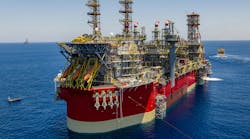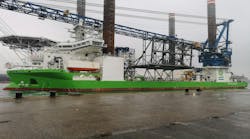Norwegian spending hits new peak
Capital expenditure offshore Norway should hit a new peak of NKr54 billion this year, according to analysts Wood Mackenzie. Much of the outlay is directed at a cluster of large new field developments, such as Norne and Åsgard off mid-Norway and the Gullfaks Satellites in the North Sea, as well as major expansion schemes for existing fields such as Ekofisk, Oseberg, and Troll.Wood Mackenzie sees spending leveling out to Nkr40 billion in both 1998 and 1999, with a further 12 developments coming along comfortably by 2000, headed in size by Statoil's Tyrihans and Kvitebjorn. Of these, 90% would be subsea or deepwater floating production projects, mirroring the move away from fixed installations of late in the UK sector.
After 2001, Norwegian spending is predicted to plummet, but the forecast does not take into account possible developments of recent giant gas finds such as BP's 2 tcf Nyk High in the Voering Basin or Saga's Lavrans/Kristin, close to Åsgard. Progress would depend on how far these fields are in the pecking order for fulfilling Norwegian gas export commitments.
But Saga is already talking in terms of an FPSO for Lavrans/Kristin, and another floater is also in contention for the second phase of Saga's Snorre development. In both cases, conceptual engineering studies have just been launched.
By the time Norwegian North Sea develop ment activity starts flagging, sights may have switched north to the Barents Sea. Norsk Hydro and Statoil have initiated large 2D seismic surveys over their newly awarded Barents acreage, with programs also likely soon from Elf Norge and Norsk Agip.
Ireland's first oil, UK licensing
Statoil has spudded its second appraisal well on the Connemara Field in the northern margin of the Porcupine Basin, off western Ireland. This is a long-reach well targeting part of the Middle and Upper Jurassic sandstone reservoir within a fault block structure. The first appraisal well should by now have completed a 60-day test, yielding the first oil ever produced offshore Ireland. Should commerciality be confirmed, the 37-million bbl field could be onstream next year via an FPSO, with perhaps 10 further development wells to be drilled.Total and Marathon also have kicked off their first campaigns in the Porcupine Basin, where there has been little exploration drilling to date. The semisubmersible Jack Bates is operating in water 2,300 ft deep for Marathon.
Finally, ARCO Ireland Offshore, Anadarko Ireland, and BG Exploration have teamed up to evaluate the country's hydrocarbon potential. ARCO and British Gas gained operatorship of nine blocks from Ireland's recent licensing round and will now review blocks on offer in the forthcoming South Porcupine Basin frontier licensing round. Pooling technical resources is becoming a feature of operations along the Atlantic Margin.
Britain's Department of Trade and Industry (DTI) has outlined plans for a five-year program of offshore licensing rounds in UK waters. The first round, to be launched later this year, will cover mature acreage across the North and UK Irish seas, with similar acreage to follow in the ensuing years. A frontier round will follow in the fall of 2000.
Also in this period, DTI is aiming for a "White Zone" round, covering the area currently disputed between Britain and the Faeroe Islands. There will also be a suspended well initiative to review finds that remain undeveloped six years after their discovery. This review will extend to suspended wellheads that may cause inconvenience or danger to other sea users.
BP slows advance of Magnus scaling
Downhole scaling, which has plagued BP's Magnus oil field since 1995, may be under control at last following the introduction of new inhibitors. Around 1.4 million bbl were lost in 1995, with injection of conventional scale inhibitor achieving only limited success. Part of the problem was the similarity between injected seawater and Magnus' formation water.BP then initiated development of new precipitation scale inhibitors and an inhibitor enhancer, as well as doubling injection rates and isolating water-producing zones. The net effect so far is that 300,000 bbl have been salvaged that would otherwise have been lost through scaling.
Another problematic UK field is Texaco's Mariner, in block 9/11a, where development solutions have come and been vetoed due to uncertainties over reserve size and accessibility. Texaco is attempting to resolve the doubts through an extended well test, but even here a re-drill of an existing well has had to be sidetracked following sand ingress. This occurred despite application of screens to supposedly protect the test equipment. The sidetrack was due to drill a horizontal section north of the original well last month, followed by testing of the heavy oil reservoir.
Mariner's reserves have been downgraded from 150 million bbl to 100 million bbl, dampening viability of the various development concepts. However, block partner British Borneo has revealed that nearby well block 9/11 B-4, suspended silently by Texaco earlier this year, uncovered a separate oil accumulation of a similar epoch to Mariner's.
The Mariner EWT plant, supplied by Montrose-based Merpro Group, is claimed to be the world's first capable of handling separation of heavy crude with high water cut and high flowrates. It was designed specifically for Mariner, flowing at 40,000 b/d with crude gravity of 14.50 API and water cuts up to 75%. The process package occupies only half the deck of a pentagon design drilling rig, leaving sufficient deck space for vital workover tasks.
Atlantia debuts in southern sector
Liberalization of the European gas markets is driving a steady stream of projects in the UK southern gas basin. Onstream next spring should be Conoco's Boulton, based on Atlantia's minimum facilities design platform (a first for the North Sea) with well conductors placed inside the jacket's four column legs. The drilling scheme includes a dual-lateral well and horizontal and deviated well sections of around 19,000 ft, drilled to within 200 ft of the targeted bottom-hole locations.Odebrecht-SLP, the fabricator responsible for the platform, will build another normally unmanned production facility for Shell's Ketch Field in the operator's "Silver Pit" complex, which should sail out to the field next August. Ketch's gas will be piped through the Caister-Murdcoh system to Theddlethorpe, Lincoln shire. In other projects, Amoco is aiming for UK government sanction shortly for the Cavendish gasfield, with a view to a 1999 production start. And BP is looking to prolong production from its Amethyst facilities through tying back the Flowers South gas find.
South Arne gravity base under construction
Amerada Hess' first Danish sector field development, South Arne, will be propped up by a 100,000 ton gravity base structure, designed by Taylor Woodrow and built at Barmac's drydock in Nigg, Scotland. The GBS, consisting of 100 interconnecting cells 17 meters high, will be able to store 550,000 bbl of crude. Topside processing facilities will be supported on the GBS via two legs, one (concrete) centrally mounted and the other, a steel lattice leg, attached to the structure's side. The completed GBS should be floated out early in 1999 assisted by buoyancy tanks which will be redeployed as ballast tanks out on the field to aid stability of the platform.Amerada may also be on the point of submitting a PDO for its Mjoelner Field on the Norwegian side of the median line with Denmark, possibly unitized with Maersk's Gert on the Danish side. A normally unmanned wellhead platform looks to be the probable development solution.
Copyright 1997 Oil & Gas Journal. All Rights Reserved.




